There are definitely some hefty words in the title but Texas Instruments (TI) has brought something new to the motor control table with its InstaSpin-FOC (field-oriented-control) solution. It is a combination of hardware and software that supports any type of three-phase, synchronous (BLDC, SPM, IPM) or asynchronous motor and it does so in five minutes or less. It will handle variable speeds and loads. Best of all, you do not need to be a motor control expert to get something to work.
Field-oriented-control is not a new motor control topic. It is just a difficult one. Essentially a system needs to adjust the power to the motor based on the position of the rotor. The position of the rotor can be obtained using sensors or feedback from the drive electronics (sensorless). The change in the phases to the motor adjust the speed and torque (Fig. 1).
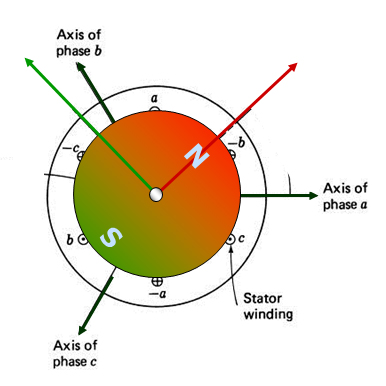 |
|
| Figure 1. | Field-oriented-control of three-phase motors can be done using sensors or without. The latter utilizes feedback information from the drive electronics. This tends to be a compute heavy task. |
Sensor-based solutions tend to be simpler to implement but require additional hardware. There is also the issue such as sensors moving out of alignment. The sensorless approach is more robust but computationally heavy so it is often augmented with hardware. The advantage is lower cost and higher reliability because there are no sensors to wear out or align (Figure 2).
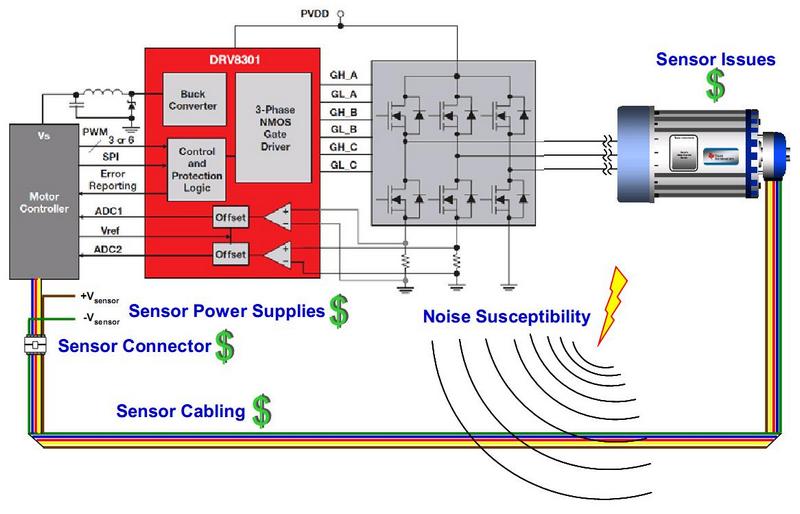 |
|
| Figure 2. | Sensored FOC System |
The challenge for motor control designers is working with the code that determines the rotor position as well as how to change the power going to the motor to get the desired rotation. This sounds easy but is actually very complex because the feedback mechanism is usually non-linear and it is also a function of load and speed. Motor vendors often provide hundreds of characterization parameters that can be utilized. The shear number of variables often deters most designers and proper utilization of the information is key to delivering software that will operate across the range of speeds, torque and acceleration needed to address many applications.
TI's InstaSpin software addresses these issues in two ways. First, there is a component that is in ROM on select TI microcontrollers including the F2806x that is part of the Piccolo family of digital signal controllers (see “Playing With Floating Point and Low Cost DSPs”). This is the “secret sauce” from TI that handles the motor. It is called FAST (Flux, Angle, Speed, Torque). There is also a runtime library for code that will go into the microcontroller's flash memory and host-based software for configuration and tuning.
To start with, a designer would hook up an InstaSpin system with a motor. An analysis application is downloaded to the microcontroller. This application, along with a host-based application, analyzes the motor attached to the system generating a profile that is then used by the software to control the motor (Fig. 3). The profiling takes about five minutes. Only the maximum voltage and current are needed. The results are a system that can control the motor from a static position to any speed within the specifications.
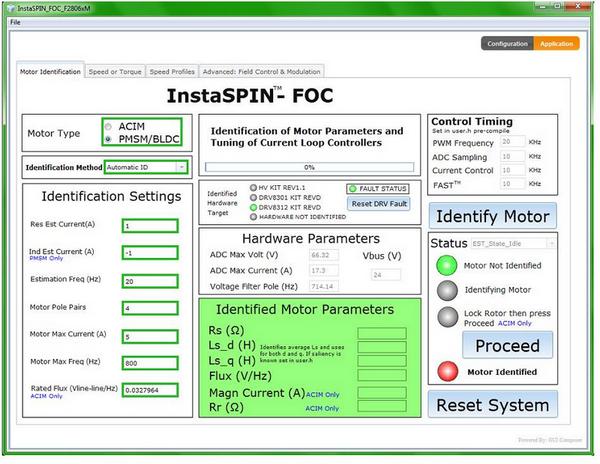 |
|
| Figure 3. | The InstaSpin-FOC profiler needs a few settings to limit the control of the motor so it does not exceed spefications while profiling. |
Once the system has been profiled the developer can control the motor using a logical interface instead of having to deal with low level hardware. They can also utilize information from the motor to address issues such as stalls and overloads. This can improve the safety of a system. For example, if an overload is detected then the motor could be turned off to prevent damage. Designers can also examine the characteristics of the system and the motor (Fig. 4).
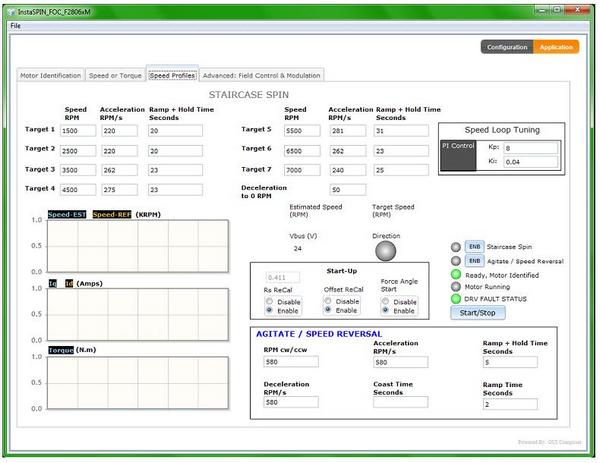 |
|
| Figure 4. | InstaSpin provides insight into the operation and profile of the motor. |
The motor can also be controlled in torque mode (Fig. 5) and that can be useful for many applications. The torque measurements are obtained like the other sensorless information. That is, the torque is actually an estimate based on the feedback from the motor as well as the power and how it is being applied to the motor.
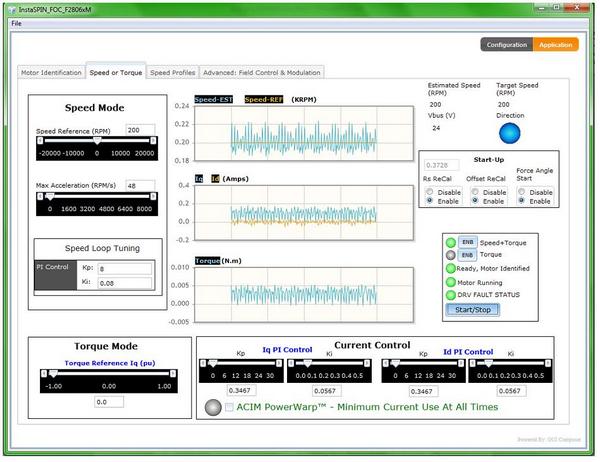 |
|
| Figure 5. | InstaSpin provides support for torque control compared to some systems that only control speed. |
Designers can tune the results from InstaSpin if desired (Fig. 6). This allows adjustments across the operating conditions that will be encountered as well as addressing issues such as mechanical inertia. Designers can also modify any of the software except that contained in the ROM.
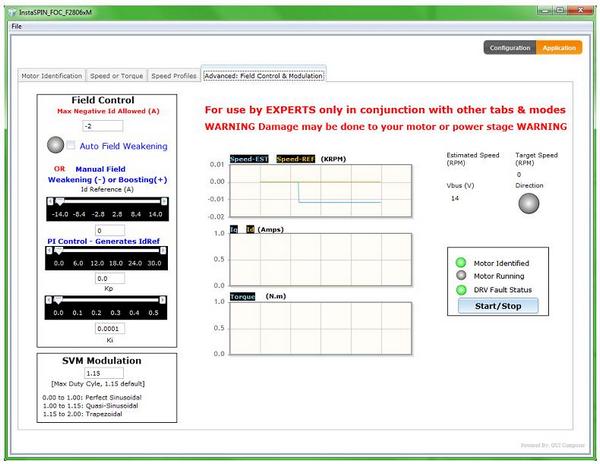 |
|
| Figure 6. | Advanced InstaSpin tuning is available to experts that may know more about the motor or the application. |
Designers can also take advantage of TI's PowerWarp software that is designed to improve system efficiency. It takes advantage of the FAST encoder to track the rotor flux angle. It helps reduce power requirements when torque demand is low by adjusting the current of the induction motor. This is the first time an algorithm has been used to reduce motor copper losses in both the stator and rotor.
Designers have been switching to BLDC (brushless DC) motors because they are easy to control using today's microcontrollers. They are more efficient that simply turning a motor on or off but not as efficient as a three-phase motor would be. These have been used with more advanced controllers when the cost could be justified. That cost just went way down with InstaSpin. Compared to basic triac controllers, InstaSpin could shave off 80% of the power requirements.
One of the reasons TI was able to build InstaSpin-FOC was the support within their microcontrollers. The voltage and current filtering cleans up input samples. It allows the system to handle offset compensation. Zero speed start up can deliver over 100% rated torque.
The object-oriented software APIs are provided with TI's MotorWare software package. It will be supporting other TI parts in addition to the Piccolo family.
TI's solution could radically change the way designers look at motors and motor control. It opens the use of more efficient motors to a wider range of designers that, prior to InstaSpin-FOC, could not reliably create a motor control system.
